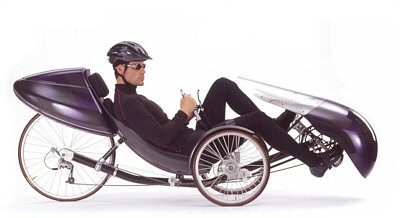Fundamentals
Tadpole or Delta?
The tadpole trike has the two wheels at the front, the delta trike has the two wheels at the rear. Is one configuration better than the other?
Windcheetah TadpoleOne of the original and best known tadpole trike designs is the Windcheetah by Advanced Vehicle Design. Above is a partially fared example of their Club Sport model. The Windcheetah uses all cast aluminum components that are bonded to a aluminum tubular frame.
Kettweisel DeltaBy contrast the Kettweisel by Hase is probably the best known delta trike design. This is a fast, light trike, renowned for its handling.
Assessing Dynamic Behavior
So from what we learned about the dynamic handing characteristics of trikes on the Why Does Tilting Matter? page -- How do these trikes stack up?
In this section I am not attempting to endorse or recommend one trike manufacturers product over another's, I am simply using these proven designs to illustrate how one might go about assessing the strengths and weaknesses of any trike design. And more to the point, how to assess which characteristics are best suited to your requirements, and on that basis, whether they should be considered for your own designs. This discussion is general and representational. As such it should not be considered definitive. From here on the trike configurations will simply be referred to as 'the delta' and 'the tadpole'.
Braking
Delta rider's CoGThe delta rider's CoG is unusually high for a trike, but it is located behind the forward tipping axis so would be stable under a 1g braking force. Conversly, riding up an unusually steep grade the trike could easily lift the front wheel if enough force was applied to the pedals in a low gear. However as trade-offs go, this is unlikely to ever be a problem in real world riding conditions, so the rearward CoG is a good idea.
Tadpole rider's CoGThe tadpole rider's CoG is lower, but located ahead of the forward tipping axis so it would tip forward under a 1g braking force. With modern caliper brakes, this would have a tendency to lift the rear wheel. On a downward slope the tipping threshold would be even less, exacerbating the problem.
Why not position the front wheels further forward? Well there are some issues with doing this including: the cross member getting in the way of the cyclists calves, and the seat becoming more difficult to stand up out of, because the riders feet are too far forward. Changing the backrest angle to 30° or less will help move the rider CoG further back.
However having the CoG slightly forward changes the weight distribution to favor understeer, which is a good thing. It also means the CoG can be raised slightly, making the seat height more practical.
Turning.
Delta turning vectorsUnder turning forces the delta rider's CoG is well placed. Likewise under combined turning and braking forces the CoG is also well places, however as we will see in this implementation the CoG is too high. The long wheel base of the delta also decreases the twitchiness of the steering, improving high speed steering control and precision.
Delta turning simulationDespite the rearward CoG placement, the delta trike will roll over under simulation (download the Juice file here). Obviously the rider experiencing the inertial feedback and with quicker reflexes could make a course correction better than I can under the simulation. Still, one must lower the CoG to make the simulation more stable. Find out about running Juice simulations here.
The rearward weight distribution also favors oversteer, meaning the trike would tend so spin out as a result of loosing traction on loose gravel.
Tadpole turning vectorsUnder turning forces the tadpole rider's CoG is well placed, and combined with the low seat, more stable than the delta. However under combined turning and braking forces there is still the possibility of tipping forward.
Tadpole braking simulationDespite the forward CoG placement, it still takes some effort to get the tadpole to tip forward under simulation (download the Juice file here). Find out about running Juice simulations here.
KMX KartThe KMX trike pictured above resolves the tadpole brake force issue by having smaller front wheels, there by lowering the rider CoG inside the forward tipping axis. Nevertheless, as this image clearly shows, with a more upright backrest angle it is definitely possible tip the trike and get it up on two wheels.
FWD
For a front wheel drive (FWD) delta trike to have adequate traction, more weight needs to be distributed to the front wheel than the rear. Ratios of 60:40 or higher are reccomended.
FWD delta turning vectorsThis weight distribution has significant implications for turning stability as this illustration clearly shows. For this reason, I would strongly advise against designing a FWD delta unless it has some capacity to tilt.
Conclusion
Although Jetrike MkII is a FWD tilting delta trike, I am switching to a tadpole configuration for my next design. The reason for this is that the forward CoG only provides a narrow tilt range with a small margin for error. Additionally when the trike is stationary it can only tilt a little bit before the trike tips over.
The Ideal Tilting TrikeBy comparison, the tadpole configuration with a properly centered CoG provides excellent traction, turning and braking stability. It provides a larger tilting range, so you don't have to get the tilt angle exactly right, and it can also be tilted further while stationary without tipping over.
Copyright © 2007 Henry Thomas
![]()










